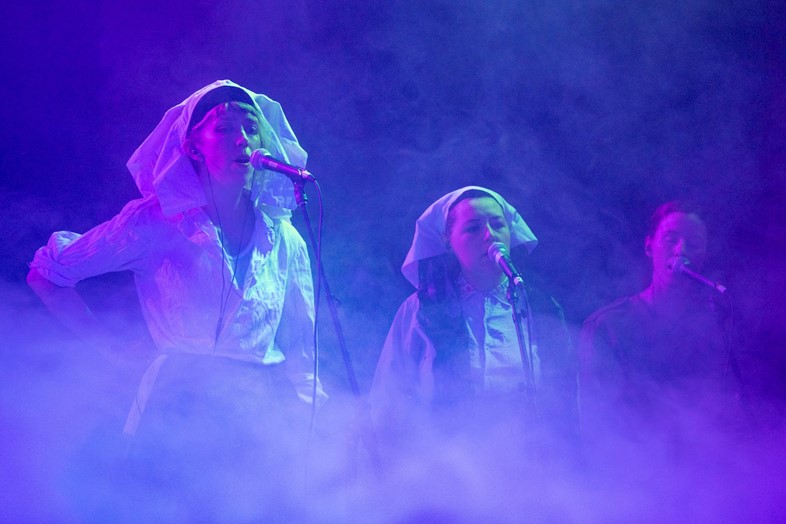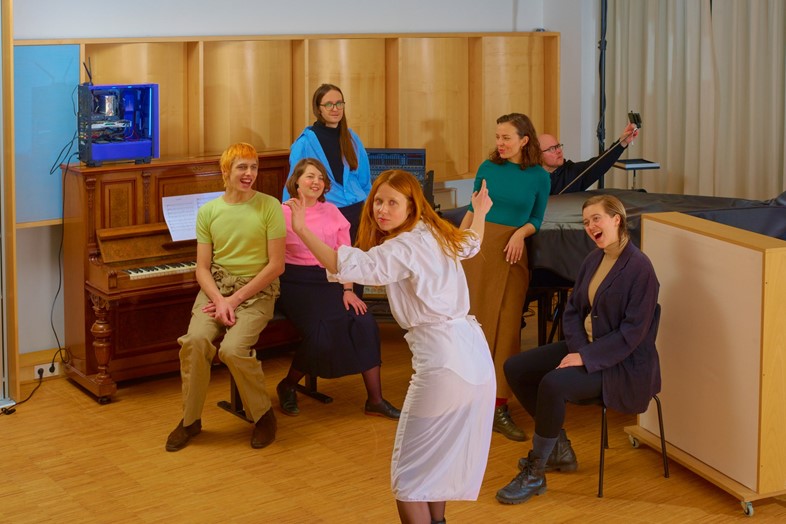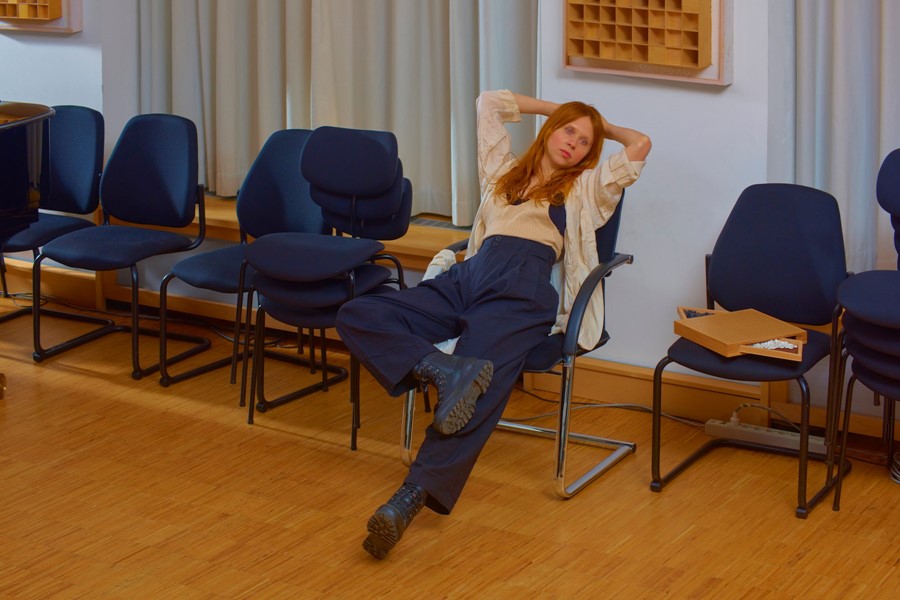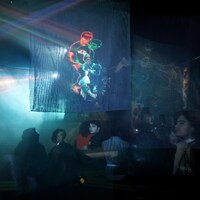The experimental musician discusses the human labour that built the Artificial Intelligence that powers her latest album, PROTO
Holly Herndon’s first album, 2012’s Movement, was inspired by her relationship to her laptop, with the experimental musician and composer using her voice to explore the space between the physical and the digital. Her second album, 2015’s Platform, interrogated digital surveillance culture, sampling recordings made by software she’d installed onto her devices to covertly eavesdrop on her private moments; it seemed remarkably prescient both formally, in its use of ASMR before many people had really heard of the term, and thematically, given the Cambridge Analytica scandal that would break a few years later.
In May this year, Herndon released her third album, PROTO, which saw her collaborate with an Artificial Intelligence she built to make music. If her past form is anything to go by, you can probably expect the ideas in PROTO to become part of the mainstream discourse within the next few years – not that she’d be particularly happy about that. “I wish that these hideous things that happened over the past couple of years weren’t the case, I wish that I was tinfoil hat,” says the Tennessee-raised musician, speaking over Skype from her home in Berlin. “I’m not deriving pleasure from it, but it is nice to see some of these conversations being brought to the mainstream. With this whole AI conversation, if we wait until it becomes cool or acceptable to talk about, then we’re going to be in the same situation, where we can no longer influence things on a protocol level, at a very functional level.”
The AI that Herndon built for PROTO is named Spawn. Developed with Herndon’s partner and collaborator Mat Dryhurst, and artist and programmer Jules LaPlace, Spawn was trained on the voice of Herndon and her ensemble of collaborators, a list that includes Dryhurst, Colin Self, Jlin, Martine Syms, Jenna Sutela, Evelyn Saylor, and Annie Garlid. Spawn isn’t necessarily what you’d expect an Artificial Intelligence to sound like. In sci-fi films, AI voices tend to be flawless and femmebot-like, but Spawn sounds far more rough and primal. Spawn was built by human beings, and she (and Spawn is a ‘she’, as Herndon has made clear) was made to work with them, not replace them.
It’s an idea brought into Herndon’s recent live performances. Following PROTO’s release, Herndon debuted a new show at Brooklyn’s Pioneer Works for Red Bull Music Festival New York (a London edition of the festival is planned for August). Where previous Holly Herndon shows have often integrated an A/V component, here, it was her human collaborators and their voices that took centre-stage. For all of the cutting edge technology that Herndon integrates into her music, her work is alive with humanity – in fact, Spawn only features on some tracks on the album, but has understandably come to dominate much of the discussion around it.
Herndon had hoped that Spawn would be able to join her on-stage at Pioneer Works, but in the end, she wasn’t quite ready in time. However, Herndon did make recordings of all her tour audiences to help create voice models for the AI. “I’m really excited to hear the difference between the LA voice, the NY voice, or the Berlin voice,” Herndon says, adding that she hopes that Spawn will be ready in time for her show at London’s Barbican Centre in October. “I don’t want to make any promises, but hopefully she’ll be performing live. The training itself can’t happen in real-time, because that takes weeks to process, but we’ll premake some sort of model that someone can perform through, so it will be collaborative, almost like an extended vocal technique or a digital processor.”
You’ve done absolutely loads of interviews around this record. Is it cool to have so many people interested in what is, at the end of the day, pretty idiosyncratic and challenging music?
Holly Herndon: It’s amazing. The initial surprise happened around Movement, and that was 2012. I was just kind of doing my own little nerdy thing in the Bay Area, I’d just started my PhD programme (Herndon recently completed her doctorate), and then all of a sudden people cared about this weird album on a broader stage. It was so exciting for me that I could have these kinds of conversations with the public.
When Platform came out, there was some criticism: “You’re overthinking it, you’re over-politicising it, why can’t you just let the music be music?” I feel like we have room in our brains for rational and emotional thought to cohabit. I would hope that one could listen to the music and still be able to respond to it without having to read an interview or understand where it’s coming from. That’s one reason why I try to embed the concept (that underlies each of my albums) into the music-making process itself. I hope that one can audibly hear the underlying concept through the aesthetic choices and the actual aural qualities.
I noticed that on PROTO, the lyrics are a lot more prominent than on your previous albums. What’s your lyric-writing process like?
Holly Herndon: I started out using the voice more as an instrument for sound texture, like a data stream, and it’s become more lyrical over time. This is probably where it’s the most intuitive process for me, where I’m doing research, reading stuff, and I have these thoughts and words floating around in my brain. Whenever I’m working on a new song, I’m usually seeing a stream of consciousness, and it’s coming from whatever I’m reading at the time. And then that filters through my jumbled up neural process, and then I will write down what my jiberish is – and there will, of course, be phrases there that aren’t jiberish. I’ll try to create a poetry around that.

I saw you play live in New York a couple of months ago, and was a little surprised, because when I saw your previous shows there was a huge visual component, whereas here, the emphasis seemed to be very much on the human performance and the vocal ensemble on-stage. What led to that decision?
Holly Herndon: The practical reason is that our video wasn’t finished in time (laughs). We do have a video now, but it’s not, like, a giant TV screen you’re watching the whole time. It’s more of a theatrical scenography that the ensemble is placed inside. So it hasn’t really changed that much, it’s just that there’s more control over the lighting and the scene.
One of the early embers of working on this album and wanting to work with the human ensemble was this kind of questioning, in the electronic music scene, of this fully automated show experience. I felt that the human was being automated off the stage, and these lights and videos were the performers. I still love that stuff, but it felt like that was the only thing I was getting access to. I was missing the human form, and the human performers as part of that. Throughout this whole process, there was a refocusing on working with the community and trying to tap into some sort of human ecstasy on stage that we could hopefully share with the audience.
Do you feel like the human narrative is something that people miss when it comes to your work?
Holly Herndon: I think in the past it has been, but this album has changed things a little bit. This album is undeniably human. You can hear the people in the space, you can feel that architecture, you can feel that it’s not just happening in-the-box. I’ve always felt like the music was very human, so maybe this just made it more clear to the audience.
Yeah, even back in 2012, around Movement, you were talking about laptops not as cold machines but as facilitators of human intimacy. With this album, there’s this AI element, but these AI systems still have to be built by people.
Holly Herndon: Exactly. These systems are part of our human culture. People have a really strange relationship with technology, like it’s this new thing, but it’s a continuum. From the fork to the iPhone, this is all part of our history of human intelligence. I think maybe the way we interact with our digital tools still feels so new that it doesn’t quite feel like a part of us.
I also think a lot of work goes into abstracting the idea that humans play such a big role in this technology – and that’s done deliberately, as well.
Holly Herndon: Absolutely. And also, the earth. This is something that my friend Kate Crawford writes about a lot through AI Now, all the earth minerals that go into our digital devices. This is something we’ve totally alienated ourselves from.
Specifically with AI, we’re presented with these perfect renditions of human behaviour that are, of course, modelled on millions of previous examples of human behaviour. The human labour definitely becomes erased through this kind of perfected, glossy version that we’re presented with. That’s one of the reasons why we wanted to really show AI in its scratchy, imperfect form, and make the voices of the ensemble audible through Spawn, so that you could hear that Spawn is just really an amalgamation of all of our human efforts that we’re putting into the training.
“This album is undeniably human. You can hear the people in the space, you can feel that architecture, you can feel that it’s not just happening in-the-box. I’ve always felt like the music was very human” – Holly Herndon
Do you see Spawn as a way of saying “we built this ourselves”, that AI is something that doesn’t have to belong to Silicon Valley or big corporations?
Holly Herndon: It is something we built, and something we can continue to build on, but I don’t want to paint a rose-tinted picture of it. These (corporate-owned) AI systems are impacting everyone’s lives, from getting a mortgage to sentencing, and it’s something that’s affecting people who don’t really have a say in it. That’s one reason why we wanted to have our own DIY version – and I mean, it’s very much like David and Goliath. We have one GPU unit, compared to a corporate AI project that would have a whole data centre crutching numbers, and also free access to the entire public human digital expression on whatever platform.
One of the reasons why we wanted to get our hands dirty with AI was to understand its capabilities and limitations a little bit more, so that we could have a little bit more informed opinion on it. It’s this black box technology, it’s really complicated, it’s hard to understand, there’s a lot of outmoded sci-fi narratives running around. I think it’s hard, sometimes, for the public to have a political project around it, or even have an informed opinion, because it is so opaque. My hope would be to reinsurge our sense of agency back into these tools. That’s not minimising how steep the learning curve is, and how difficult it is to use these tools – it is really complicated – but I’m hoping our little intervention can show that we can deal with it, we can create a counternarrative. I would hope that more people would want to get involved and think about it and form their own opinions about it.
A lot of the software that we’re using is really available on GitHub. That’s where we saw a lot of creative work around neural networks starting around 2016/17, there were several white papers released with the code available on GitHub. Of course, there’s a huge learning curve to that as well. It’s not consumer-grade software, you have to know Linux, and you have to install it. There’s a certain technical literacy that is required to work with it. But it has been great to see people use these new neural network architectures that are available. We’re all downstream from research institutions, whether those be corporate or academic, so we’re all responding to the next breakthrough and then trying to make sense of what that means for us as humans and as a society.

Do you consider your music futuristic?
Holly Herndon: I think it’s funny when people think that the work I do is ‘futuristic’, because to me, it feels so situated in today, and the now. I’m behind in many of the conversations that are happening in niche academic circles, and who-knows-what behind the doors at Facebook. I think it’s situated in the present, but music struggles to be in the present. I feel like that’s a fairly new phenomenon, like there was a time when music was at the forefront of pushing culture. I’m not exactly sure how to put that into words, but I feel like music is very much steeped in nostalgia. Of course, it’s also an economic question – musicians are trying to survive…
I think I get why people retreat to nostalgic forms of music, although I wish they wouldn’t.
Holly Herndon: Yeah, I get it too, and I also get that different people have different relationships to music. When I’m listening to music, it’s active listening, I can’t just chill out. For a lot of people, it’s a passive experience, and a lot of that is through the distribution networks that have developed in music through the last couple of years. I feel like even active listeners are being turned into passive listeners, and that definitely changes the cultural force and dynamic of music as an artform.
I was listening to a political podcast yesterday. They were talking about how Donald Trump understood, really early, that politics is downstream from culture. When they say ‘culture’, I don’t think music is necessarily a part of that anymore. I think a lot of the emergent culture that’s happening is in weird online communities around gaming, and around YouTube. Music, in some ways, has taken a backseat to a lot of that. I really value the importance of subculture. As someone who grew up in rural east Tennessee, I was presented with this mainstream worldview, and it was through access to subcultures that I was able to see that there are other people in the world with different worldviews, and then I was able to question all of them and come up with my own. I lament the loss of subculture.
“One of the reasons why we wanted to get our hands dirty with AI was to understand its capabilities and limitations a little bit more... My hope would be to reinsurge our sense of agency back into these tools” – Holly Herndon
Right, what can you really do when the biggest artist in the world is also celebrated as the most exciting? Someone like Drake just takes from all these actual, real subcultures, but then he’s praised for it. When that’s the cultural climate, what can you even rebel against?
Holly Herndon: And we have this insane attribution issue. I mean, this is nothing new, but I think this is something that AI will exacerbate in the future. Some kid somewhere in rural Texas comes up with this new beat pattern, and that becomes the sound of the biggest pop star’s album – but monetarily, or even in attribution and naming, there’s no way for that to flow back to the origin. I think there’s a problem with this decontextualisation of music from its source. When you have this playlist culture, where people don’t even look to see who the artists are, these things that are so important to contextualise where music comes from, (you’re missing the opportunity to say) there’s this community over here, check out their work as well, support them.
A few years ago, I was interviewing Jean-Michel Jarre, and he was talking about what role the artist would play once AI was at the level where it could write a song that people love. I don’t think we’re at that level yet.
Holly Herndon: I think that when it comes to music that has clear ways of applying the ruleset, like anything that’s genre-specific or idiomatic, it will be pretty easy for an AI to recreate – that’s great for muzak, it’s great for if you have a specific genre in mind. The real truth is that AI is both really smart and really stupid. It’s really good at certain things, and really bad at others. So it’s really bad at context, it’s bad at immediately responding to its environment, it doesn’t have all of the sensory abilities of the human body – the eyes, the ears, the hair on our body that stands up at certain moments – those are the things where we have privileges over the AI. But it is really good at statistical analysis, way better than our brains are. It just depends on how it’s used. I think we’re gonna see people trying to make money off of endless muzak, and that is really boring, and not at all what I’m interested in.

I suppose the idea that AI could undermine the artist is funny too, because it’s basically already happening. People have adapted their style to satisfy Spotify’s algorithms.
Holly Herndon: That’s kind of how the pop industry works, in a way. Each song has what, 20 writers? And that means you have 20 human intelligences, scraping whatever subculture they’re looking into, creating some sort of amalgamation of that sound, and adding that as one data point to the song. So AI just speeds up that process and makes it way more efficient.
Do you have any advice, or a starting point, for how musicians might begin to think about incorporating AI into their work?
Holly Herndon: I would encourage people to figure out what their stance is going into it. You don’t have to have some sort of fully formed thesis, but that really helped me. (I decided early on that) I wanted to work with sound as material, rather than MIDI data, because I didn't want to do this regurgitation of the past, so that closed off a whole section of research to me. If you have an idea of what you’re looking for, I would just encourage people to go on GitHub, download the free software, and just try playing around with it. (Using the software) is very frustrating. We were fortunate to get a grant from BeBeethoven so we could pay Jules LaPlace, who’s our developer. He spent a lot of time digging through white papers and installing different software and trying out different things. We had a major leg up there, and then even that took us six months to a year to get anything that we found aurally interesting. You need to have patience.




